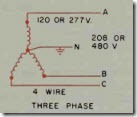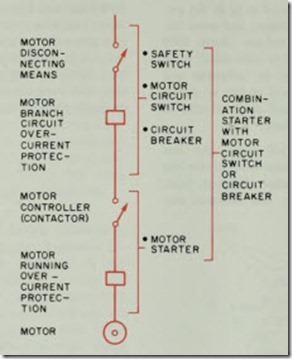MOTOR TYPES AND LINE DIAGRAMS
De Shunt Motor. Main field winding is designed for parallel connection to the armature; stationary field; rotating armature with commutator; has a no-load speed; full speed at full load is less than no-load speed; torque increases directly with load .
De Series Motor. Main field winding is designed for series connection to the armature; stationary field; rotating armature with commutator; does not have a no-load speed; requires solid direct connection to the load to prevent runaway at no load; speed decreases rapidly with increase in load; torque increases as square of armature cur rent; main motor for crane hoists; excellent start ing torque.
De Compound Motor. Main field both shunt (parallel) and series; stationary fields; rotating ar mature with commutator; combination shunt and series fields produce characteristics between straight shunt or series de motor; good starting torque; main motor for de driven machinery (mills or presses).
Ac Squirrel Cage Motor. Single or three phase; single phase requires a starting winding; three phase, self starting; stationary stator winding; no electrical connection to short-circuited rotor; torque produced from magnetic reaction of stator and rotor fields; speed a function of supply fre quency and number of electrical poles wound on stator; considered as constant speed even though speed decreases slightly with increased load; good starting torque; high inrush currents during start ing on full voltage; rugged construction; easily ser viced and maintained; high efficiency; good run ning power factor when delivering full load; requires motor control for stator windings only.
Ac Wound-Rotor Induction Motor. Characteris tics similar to squirrel cage motor; stationary sta tor winding; rotor windings terminate on slip rings; external addition of resistance to rotor cir cuit for speed control; good starting torque; high inrush current during starting on full voltage; low efficiency when resistor is inserted in rotor wind ings; good running power factor; requires motor controls for stator and rotor circuits.
Ac Synchronous Motor. Stationary ac stator windings; rotating de field winding; no starting torque unless motor has starting winding; gener ally poor starting torque; constant speed when motor up to speed and de field winding energized; can provide power factor correction with proper de field excitation; requires special motor control for both ac and de windings to prevent the de field winding from being energized until a specified percent of running speed has been obtained.
POWER SUPPLIES
All electrical power supplied as ac or de; pri marily ac; generation, transmission, and some dis tribution of power at high voltage (above 5000 volts) or medium voltage (600 to 5000 volts); most power distribution of voltage for industrial and residential use is 600 volts and under; ac power generally at 60-Hertz frequency; ac distribution at use location single or three phase.
Single-phase. Two wire, 120 volts, one line grounded; 120/240 volts, three-wire center-line grounded; residential distribution, lighting, heat, fractional horsepower motors and business machines.
Three-phase. Three-wire delta 230/460 volts, 580 volts; four-wire wye 208/440, 277/480 volts neutral line grounded; primary industrial power distribu tion; main motor drives, integral horsepower mo tors, lighting, heating, fractional horsepower mo tors, and business machines; used as three-phase or single-phase power supply .
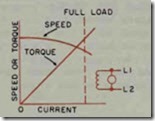
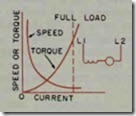
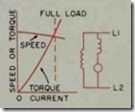
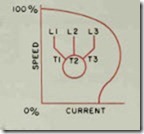
![Ac-Wound-Rotor-Induction-Motor_thumb[1] Ac-Wound-Rotor-Induction-Motor_thumb[1]](http://machineryequipmentonline.com/electric-equipment/wp-content/uploads/2020/04/Ac-Wound-Rotor-Induction-Motor_thumb1_thumb.jpg)


